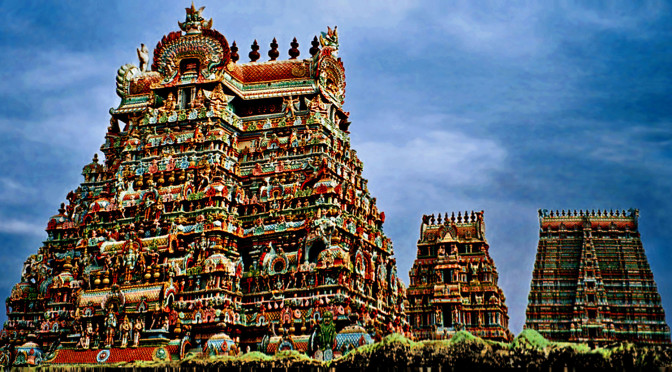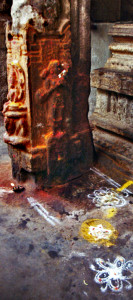The verdant landscape of the state of Tamil Nadu in the southern tip of India is punctuated by the spectacular towers which rise above the rooftops of its fabled temple towns. The Muslim conquest of the north did not permanently extend into this southernmost region of the subcontinent; thus it was able to preserve intact most of its ancient temple buildings which have functioned uninterruptedly as centers of Tamil cultural life. These great southern temples were maintained, embellished and enlarged through the patronage of powerful ruling dynasties from the 10th to the 17th centuries; from the Pallavas of Kanchipuram to the Cholas of Tanjore the Rayas of Vijayanagar and the Nayaks of Madurai.
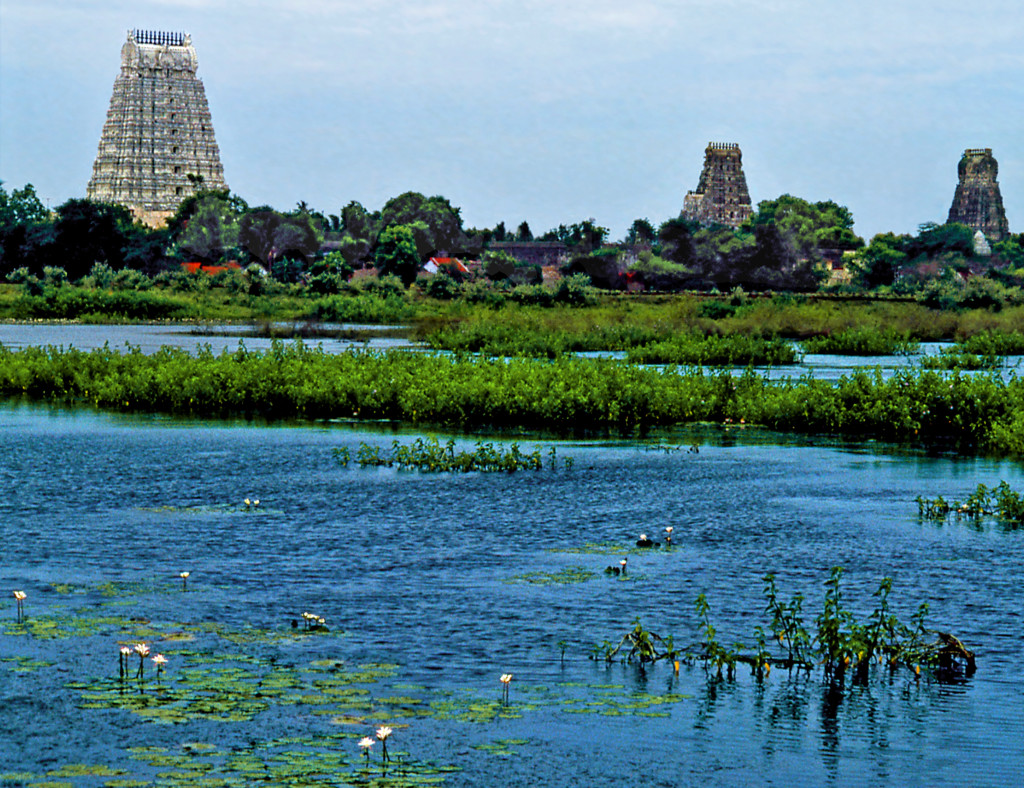

Temple towers of KANCHIPURAM dominate the skyline for miles around. As one of seven sacred cities of India and the capital of several southern dynasties, Kanchi’s ancient temples reflect its historical import-ance. The town is a traditional silk-weaving center famous throughout India. The Ekambareswarar temple dedicated to Shiva comprises five enclosures and a thousand-pillared hall. Its colossal gopura, built by the kings of Vijayanagar in the 16th century, is one of the tallest in India.
The development of the southern temple style reflects the expansion of the temple precinct into the surrounding town and its growing involvement in community life. The original sanctuary eventually became hidden inside a series of concentric walled enclosures (prakara) covering a vast area. These enclosures follow a progressive hierarchy from the outside toward the center, with the holiest and most restricted areas being those closest to the inner shrine housing an image of the deity to whom the temple is dedicated.
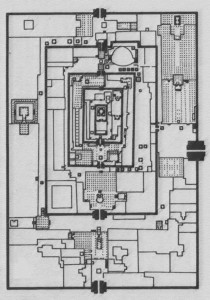
The enclosure walls are topped at each cardinal direction by colossal multi-storied gateway towers (gopura) which can rise to 200 ft. in height but diminish in size as they approach the inner shrine. Gopuram have tapering rectangular profiles capped by huge barrel vaults. The brick cores are covered by thousands of figures from the vast Hindu pantheon molded in stucco and painted in brilliant colors. They depict a vibrant, crowded and colorful celestial realm mirroring the panorama in the streets below.
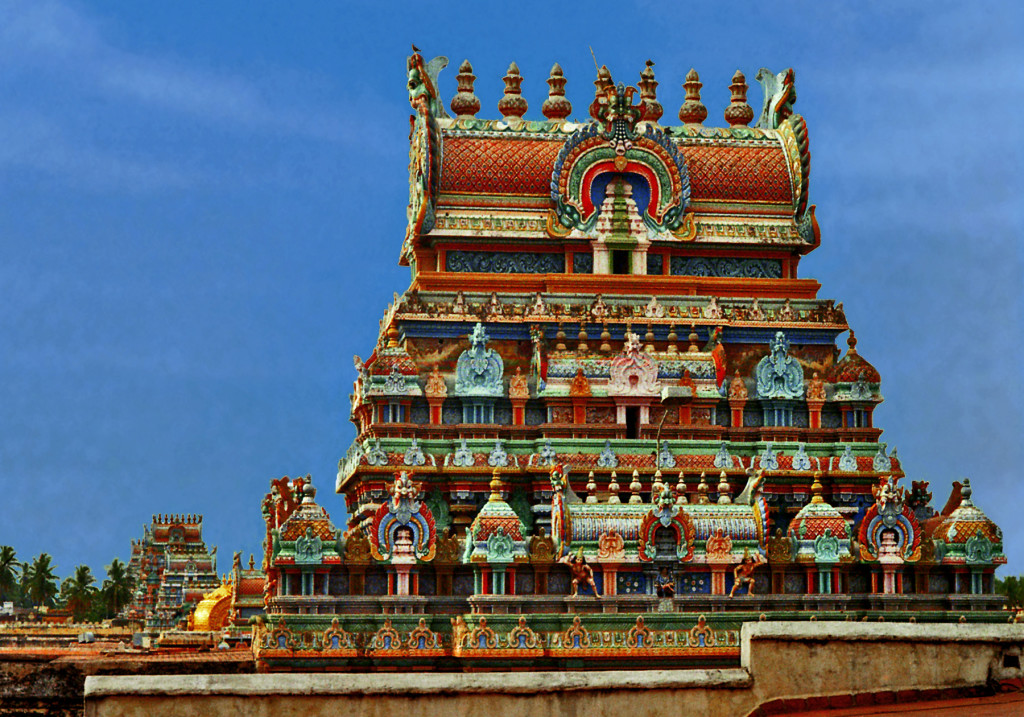
The town of SRIRANGAM occupies an island in the Kaveri River near the city of Tiruchirapalli. The seven walled enclosures of the Sri Ranganathaswamy Temple cover 156 acres and extend into the sur-rounding town. The first three enclosures are thronged with shops and houses for the sacred precincts only start at the fourth enclosure where visitors must leave their shoes. Non-Hindus may not proceed beyond the second enclosure surrounding the gold-roofed shrine dedicated to the god Vishnu in a reclining form known as Ranganatha. The temple is a major pilgrimage destination for Vishnu devotees, filled with shrines to his various avatars including Rama and Krishna.
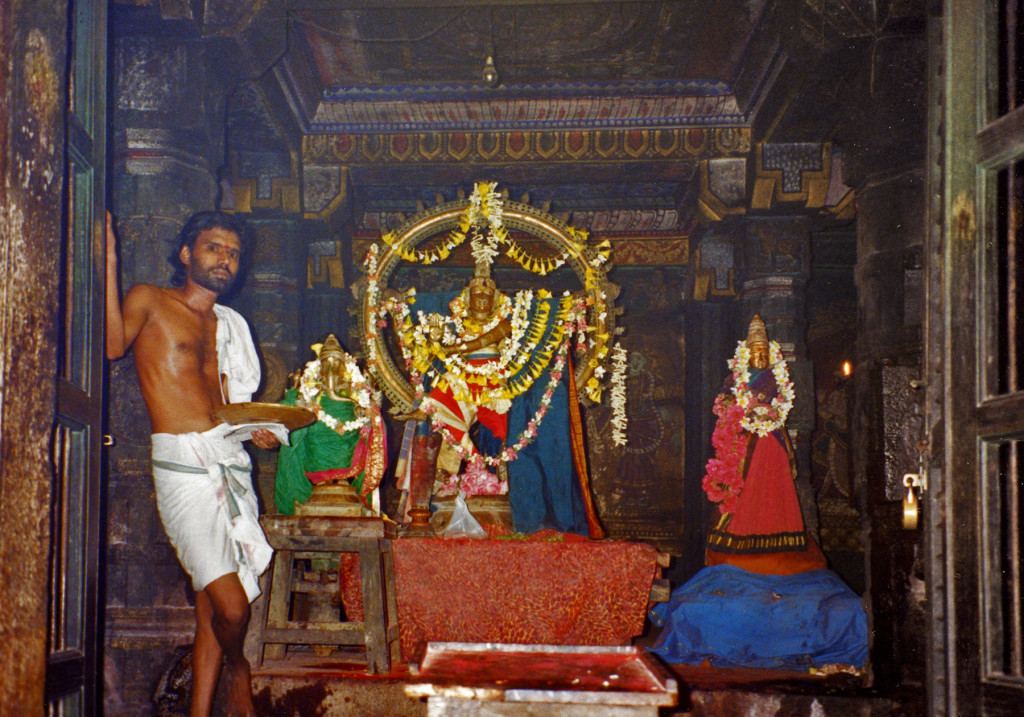
Every day a series of rituals is performed by priests to awaken, bathe and clothe the image in the sanctuary, while devotees recite prayers and present offerings of food and flowers (puja) to receive the blessing (darshan) of the deity. Only Hindus are allowed inside the innermost sacred enclosures. In contrast, the outer enclosures are a maze of pilgrim hostels, houses for temple workers, stables for the temple elephants, souvenir shops, food stalls and flower vendors in what amounts to a bustling small city within a city.
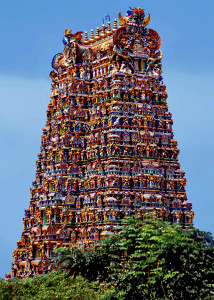
MADURAI, of legendary antiquity, is the most famous temple town in Tamil Nadu. The great Meenakshi temple was built over hundreds of years, achieving its present dimen-sions in the 17th century. It is a Shiva temple dedicated to his consort the goddess Parvati, who is worshiped here as her avatar Meenakshi. The temple is entered through twelve gateways topped by astonishing gopuram covered with thousands of painted stucco figures, rising 170 ft. above the town.
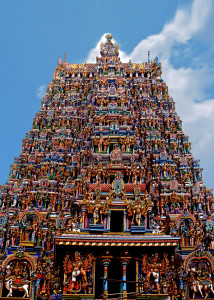
The Meenakshi temple also boasts several exquisitely carved pillared halls; one hall houses a bustling bazaar where merchants ply their trade under the benevolent gaze of the deities. The temple remains the geographic and social center of Madurai, crowded with worshipers and tourists by day; while in the cool of the evening locals congregate around the water tank to socialize, relax, and enjoy the chanting and devotional music.
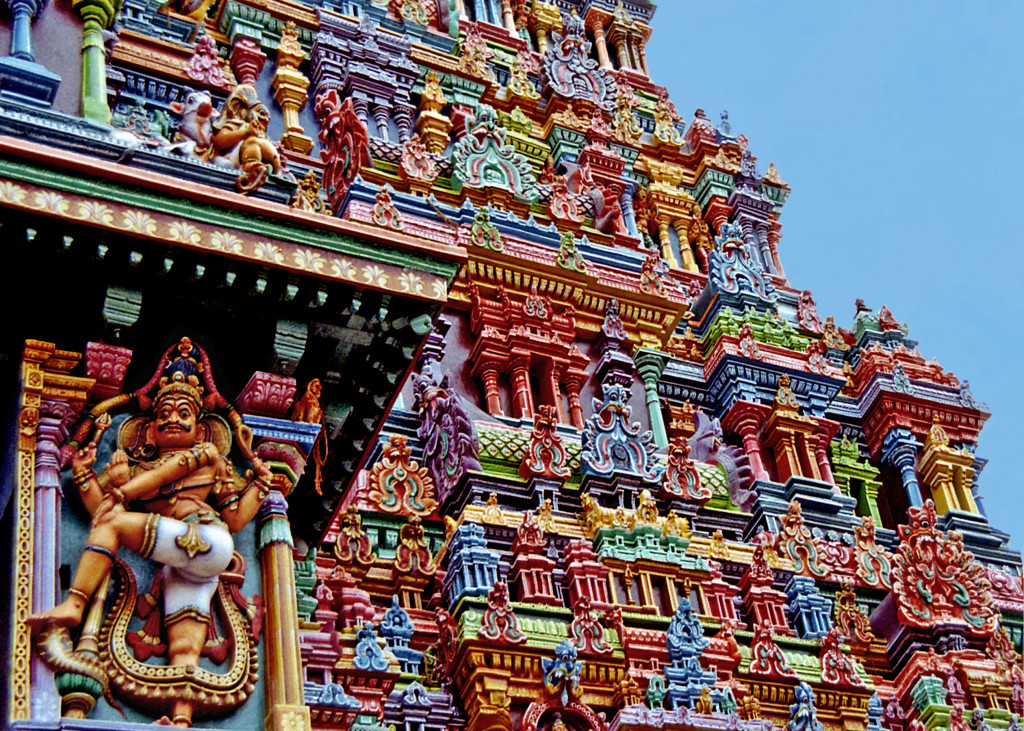
Another architectural feature of southern temples are the so-called “thousand pillared halls” where the supporting stone columns have been carved in the round with figures of deities, mythological beasts and rearing horses. These spacious halls served a variety of purposes, like recitations of Hindu scriptures and epics and performances of sacred music and dance. At the height of their glory the temples of Tamil Nadu were renowned centers of learning and culture maintaining their own corps of scholars, artists, dancers and musicians.
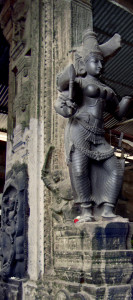
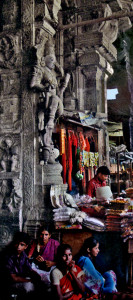
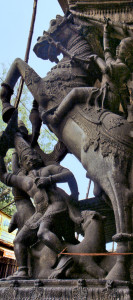
Over time, the patron deity of each locality took on the guise and assumed many of the functions of a ruler, such as granting audiences, accepting tribute and presiding over a busy calendar of religious festivals. Temple festivals often include processions where images of the gods are paraded in elaborate chariots (ratha) through the town. Beautiful bronze images were created especially for such festivals. Cast in the lost-wax process they are unique pieces which, like the famed Chola bronzes (c. 850-1250 CE) represent the height of South Indian sculpture. The best known subject to emerge from this tradition of Chola processional bronzes is Shiva Nataraja, the Lord of the Dance. This graceful yet powerful image synthesizes profound philosophical concepts: the god tramples the demon of ignorance while performing the cosmic dance of creation and destruction within a halo of fire. His serene countenance and hand gesture banishing fear represent the enlightened acceptance and resolution of opposites.
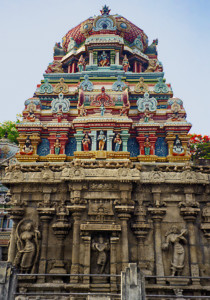
SRIRANGAM is the largest temple complex in India and the largest active Hindu temple in the world (only Angkor Wat in Cambodia which no longer functions as a temple surpasses it). Many ruling dynasties of south India contributed to its construction and decoration over the centuries. Most structures date between the 14th and 17th centuries, from its reconstruction after occupation by the Sultans of Delhi in 1371 to its great expansion under the kings of Vijayanagar.
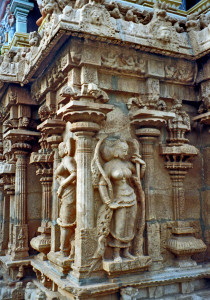
Srirangam boasts twenty-one huge gopuram covered in brightly painted sculptures. This vast temple is an amazing architectural achievement. Yet, off the beaten path, it is seldom visited by tourists adding to the unsophisticated genuineness of the place. Wandering the labyrinth of shrines, gardens and halls, visitors encounter both the garish and naive, and the refined and exquisitely crafted, in a heady juxtaposition of dazzling color and shadows.
The famous temples of Tamil Nadu with their numerous festivals attract multitudes of visitors, for undertaking pilgrimages to sacred places (tirtha-yatra) is a tradition for devout Hindus. Pilgrimages attest to the enduring power of the spirit of place inherent in all sacred locations, with their unique manifestations of energy capable of profoundly affecting and transforming all who visit them.
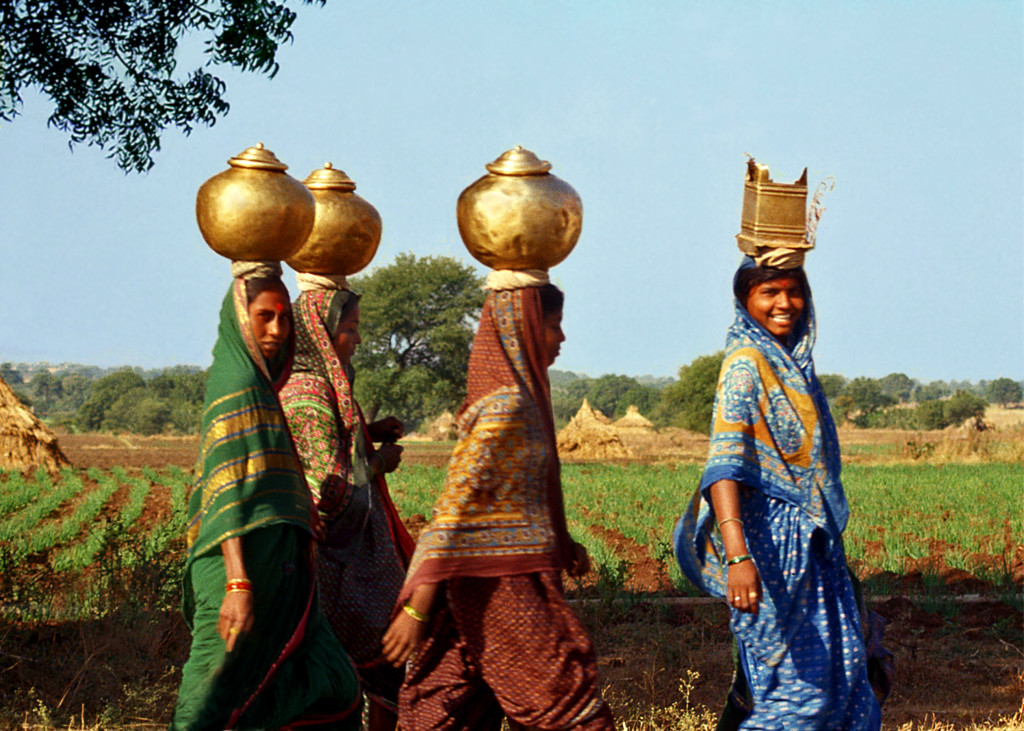
________________________________________________________________________

